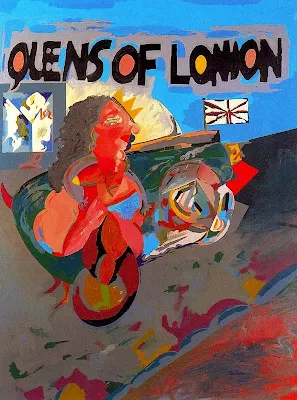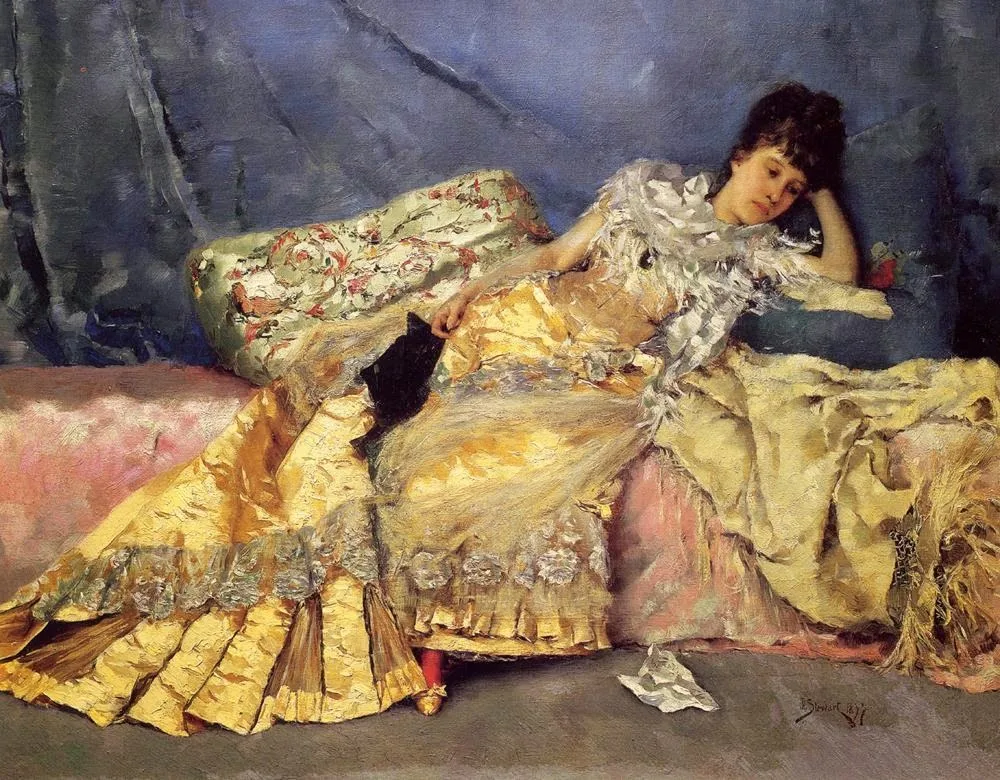Carlos Alcolea. Matisse
de día, Matisse de noche, 1977. Painting. Museo Nacional Centro de Arte
Reina Sofía Collection, Madrid.
Carlos Alcolea (A
Coruña, 1949 - Madrid, 1992) is recognised as one of the leading protagonists
of the so-called New Figuration in Madrid, which emerges in the early seventies
and continues for the next decade and whose favourable reception coincides with
an emerging trend towards a melange of critics, galleries and art markets.
Alcolea lives
painting intensely and passionately, as a language of shapes, colours,
gestures, winks and meanings. In the beginning, he adopts some basis from Pop
showing his European side, with David Hockney as the main reference. Alcolea
considers that paintings cannot be created from ideas, but from experience and
vision, which leads him to vindicate the practice of art, painting as a trade
and the theme as the ultimate foundation of the painting.
Recognisable in his
work is a lively and acid colour palette as well as a tendency to use large
fields of gently blurred colour, which result in luminous paintings. The role
of the line, drawings and his art history lessons (from Titian Vecellio to Paul
Cézanne, Claude Monet and Henri Matisse) can also be appreciated along with the
concepts of paradox and reversibility, which manifest in the recurrence of the
representation of the Möebius strip. Autorretrato. Moebius y su amigo (1975) is
an example of this, as well as works like Dassein, (1977) and Matisse de Día,
Matisse de Noche (1977), which act as formulae of distinction and "upon
which painting is established and supported", as noted by Ángel González,
curator of the exhibition.
Alcolea is a dandy
and an intellectual who creates his own iconography stemming from a number of
themes appearing at the beginning of his career. The artist emphasises these
themes and their variations, because as he himself says, "thinking does
not exhaust the idea." One of the recurring themes is swimmers and the
pool so that he can then use water as a state (liquid) and as a medium as in
Los Borrachos (1979-1980). The story of Lewis Carroll's Alice in Wonderland
allows him to enter the magical world of underground adventures; another medium
that fosters the imbalance. Thus, this alleged figuration present in the
swimmers, intellectualised portraits of Ángel González (1980) or María Vela.
Veccellia (1982) or figures extracted from imaginary Pop, such as the Queen of
England, become an iconography of a swallowed experience.
His paintings are a balance between colour and composition, like in La camarera roja, (1973) or Finisterre (1988-1989) and within them, the clearly visible horizon line dominates. From 1975-1976 the size of the canvas grows and he works diptychs and triptychs in pieces such as Alicia en el país de las Maravillas or Alicia a través del espejo (1979), where he emphasises the duplication and consistency of materials "In or out of the painting, but in the frame" as the artist says.
Recognisable in his
work is a lively and acid colour palette as well as a tendency to use large
fields of gently blurred colour, which result in luminous paintings. The role
of the line, drawings and his art history lessons (from Titian Vecellio to Paul
Cézanne, Claude Monet and Henri Matisse) can also be appreciated along with the
concepts of paradox and reversibility, which manifest in the recurrence of the
representation of the Möebius strip. Autorretrato. Moebius y su amigo (1975) is
an example of this, as well as works like Dassein, (1977) and Matisse de Día,
Matisse de Noche (1977), which act as formulae of distinction and "upon
which painting is established and supported", as noted by Ángel González,
curator of the exhibition.
ΚΡΙΟΣ
Της
νηφαλίου πομπής τα περιστέρια
Χτυπούν
τα ράμφη τους στα γυάλινα ανθογυάλια
Κι’
από τα βήματα των οδηγών
Ανθούν
τα κόκκινα λουλούδια των ενόρκων
Για
την συσπείρωσι στους θάμνους
Της
δεκτικής προδιαθέσεως των κρίνων
Στα
βελουδένια γάντια των ανθρακωρύχων
Όταν
σκορπούν τα σκύβαλα στους κύκνους.
Ανδρέας Εμπειρίκος, «Ενδοχώρα»,.
ΝΑ ΜΗΝ ΕΧΟΥΝ ΖΑΡΕΣ
Να
μην έχουν ζάρες οι μορφές, αδρές,
ζάρες
μίσους, πάθους, πόνου, μα χαρές,
στην
ψυχή να πλένε και να μην ξεσπούν,
φυλαχτές
για ωραίες, που θα τις χαρούν.
Είναι
σαν εικόνες οι άνθρωποι βουβοί,
σαν
ιππότες, άγιοι, όμορφοι, καλοί·
κατεβαίνουν όλοι
δίχως πονηριά
μες
στο μεσημέρι, μες στη δημοσιά.
ΡΩΜΟΣ ΦΙΛΥΡΑΣ
Ο
ΚΥΚΝΟΣ
Ο
μόχθος τούτος, που απ’ του ακόμα ακάμωτου τη γεύση
μπορεί
να διέρχεται, μα σάμπως να φορά αλυσίδες,
τελείως
με την άκτιστη του κύκνου μοιάζει πλεύση.
Μα
και η θανή: ό,τι στη μη αντίληψη μάς κατεβάζει
αιτιών
και λόγων που διορίσαμε ασφαλείς νησίδες,
με
το περίτρομο κεφαλοβούτηγμά του μοιάζει –:
μες
στα νερά που το χωνεύουνε γαληνεμένα,
γλυκά,
στον όλβο μέσα μα και σαν παρωχημένα,
αποχωρούν
και αποτραβιούνται ρεύμα με το ρεύμα,
κι
ενόσω εκείνος, ηρεμότατος και με την τόση
ολοένα
πιο βαθειά και πιο βασιλική του γνώση,
ατάραχος
κινά να φύγει δίχως ένα γνεύμα.
Μετάφραση:
Γιώργος Κεντρωτής.
RAINER MARIA RILKE
ΦΩΝΕΣ
ΜΕΣΑ ΣΤΗ ΝΥΧΤΑ
Στο
κοίλωμα του χρόνου μια σπονδή
Και
πέρασε η ώρα που περνάει
Κι
όμως το βράδυ και το γέλιο σου κι αυτή η φωνή
Που
πάει τόσο βαθειά μας και μαδάει
Δεν
πέρασε στην ώρα που περνάει.
Και
ο πόθος μας, χωρίς κανένας δισταγμός
Καθόλου
να παρεμποδίζη
Έστω
και τόσο δα την ηδονή
Που
σφύζει μέσα μας ξανά και πλημμυρίζει
Σαν
στρόβιλος του βαλς που πάλι ανθεί
Και
σε σαλόνι πλήρες κόσμου φτερουγίζει
Θα
την γεννήση πάλι την φωνή
Που
πάει τόσο βαθειά μας και μαδάει
Κ’
έτσι σαν πράγματα που λαχταρούν πολύ
Και
τούτες οι σταγόνες πια να πέσουν
Κ’
αίφνης πηδούν και πέφτουνε βροχή –
Στο
κοίλωμα του χρόνου μια σπονδή
Πέφτουν
και πέσανε κι ωστόσο θα μας μείνουν.
Και
τίποτε δεν μας αφήνει πια
Χωρίς
αυτές την νέα στιγμή που ζούμε να την ζούμε.
Ανδρέας Εμπειρίκος, «1934, Προϊστορία ή Καταγωγή».




















%2BLa%2BPromenade%2B1892.jpg)


















